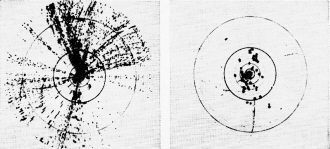News Briefs |
|
Radio-Electronics magazine's November 1959 issue had a few interesting tidbits in the News Briefs section. The first is a note about Major Edwin Armstrong's estate having won a patent infringement case against the Emerson Radio & Phonograph Co. Maybe he wouldn't have committed suicide by jumping out a window if he hadn't had to fight so many IP (intellectual property) battles in his lifetime. Interestingly, the news also mentions that he received more than $5 million in royalties for his FM radio patents. Another item of note is the introduction of secondary radar (aka IFF, identification friend or foe, in military terminology). IFF is not a passive reflected signal system, but uses a transponder in the aircraft to reply to the received signal on an offset frequency. The reply can include parametric information about the aircraft such as altitude, a unique identification (squawk) number, etc. It is a significant enhancement to primary radar, particularly in crowed environments. A scan of the entire page is included if you want to see more of what was considered important news of the day. New Briefs: 11/1957 | 8/1958 | 11/1959 | 2/1960 | 4/1960 | 8/1960 | 3/1961 | 5/1961 | 6/1961 | 12/1961 | 3/1963 | 4/1963 | 8/1963 | 9/1963 | 8/1964 | 12/1964 | 1/1967 | 3/1967 | 4/1967 | 9/1967 | 4/1968 News Briefs FM's Major Armstrong got further posthumous vindication in his long-running legal battle against radio and TV set manufacturers. Judge E. L. Palmieri found Emerson Radio & Phonograph Co. guilty of having infringed patents filed in 1933 and reissued in 1940 concerning "important discoveries in the radio art." The inventor of wide-band frequency modulation received almost $5,000,000 in FM royalties during his lifetime. His first patent infringement suit, against RCA and NBC, was settled for nearly $1,000,000. His widow and estate have six more similar suits pending. Air Traffic Safety will be improved greatly with the general adoption of a new "secondary radar" system commissioned recently at New York's International Airport. The new radar beacon system differs from ordinary radar in that, instead of depending on reflections from aircraft, it sends out a triggering signal that trips a transponder in the aircraft, which sends back a pulse to the interrogating radar. These are of course vastly stronger than reflections, greatly increasing the range of the system. This is especially important in the case of fast-moving jets. The new system requires two additional pieces of apparatus. One is an interrogator on the ground to send 6-μsec pulses at 1030 mc via a small antenna atop the regular radar antenna. The other is a transponder in the plane, a device somewhat similar to the IFF equipment of World War II. It returns 1/2-μsec pulses so coded as to help the ground operator identify the plane. A special synchronizing system also helps by reducing "clutter" from unwanted signals (see photo). The system is now in use at three New York area control points and is expected to go into 13 other major air-traffic centers within a few months. At least one airline has already equipped its planes with transponders, and others are installing them rapidly. It's anticipated that savings in time and fuel, as well as human life, will be substantial. The system was coordinated and installed by Airborne Instruments Labs, Mineola, N.Y. Danger from Radar and similar high-power generators of microwaves is being lessened aboard the guided-missile cruiser Galveston and other ships similarly equipped, by placing a small neon lamp on each man's uniform. The lamps light up at power levels equal to 5-6 milliwatts per square centimeter of body area - about half the minimum safe level for humans. Discovery of the technique is credited to Lieut. Walter Johnson of the Navy Medical Corps, who stumbled onto it the uncomfortable way, while carrying a number of neon bulbs in his back pocket.
Posted April 6, 2022 |
|

